Lake Kerkini
It's simple - Lake Kerkini offers some of the most accessible, and best, opportunities for both birding and bird photography in Europe. As the year unfolds January and February can be cold, and, wildfowl numbers reach their peak with over 20 000 Pochard often with a handful of Red-cresteds. Spotted and White-tailed Eagles are frequently seen, Great White Egrets are everywhere. Dalmatian Pelicans are looking their very best and Cranes are increasingly arriving to spend the winter here, with 28 in February '13.
Migration begins in early March, with the arrival of pioneering Garganey and Osprey. White Storks arrive towards the end of the month. Migration gathers steam through April into early May, when every bush seems to hold warblers. Glossy Ibis are regular and there can be over a thousand of each species of pelican.
The early summer sees the drowned forest alive with herons and egrets. Golden Orioles sing in the poplars and Bee-eaters and Rollers sit on the wires. Great Spotted Cuckoo bred in 2010.
Returning wader migration begins as early as late June, continuing into October, although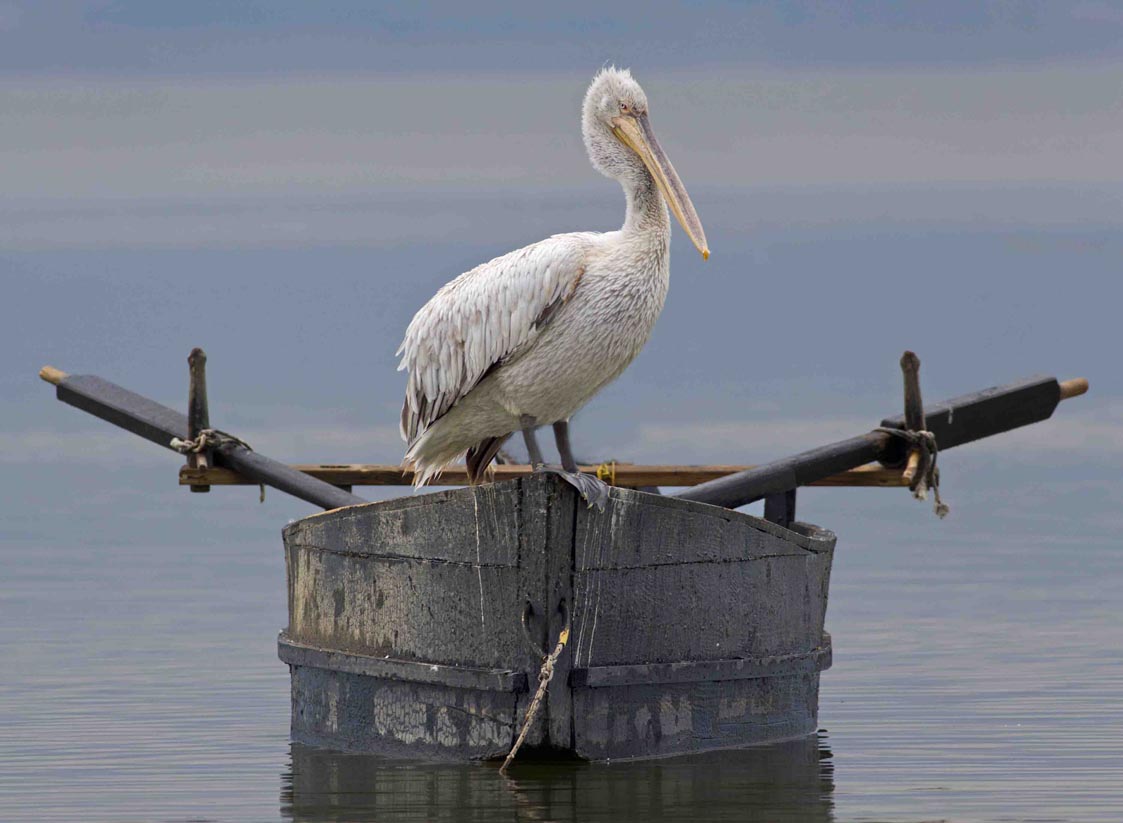 by then numbers are small. The autumn sees the water level at its lowest, exposing acres of mud, particularly at Mandraki and along the eastern embankment. This is attractive to waders but they are often some considerable distance away. Collared Pratincole pass through in good numbers in early autumn. Pelican numbers build again as Dalmatians arrive to spend the winter and Whites stop off on passage.
by then numbers are small. The autumn sees the water level at its lowest, exposing acres of mud, particularly at Mandraki and along the eastern embankment. This is attractive to waders but they are often some considerable distance away. Collared Pratincole pass through in good numbers in early autumn. Pelican numbers build again as Dalmatians arrive to spend the winter and Whites stop off on passage.
October typically sees the Lesser-spotted Eagles replaced by Spotteds. The remaining months bring the ducks back, together with Lesser White-fronted Geese, which spend time here before moving on south-east to the Evros delta.
In the winter of 2007 - 2008 the total number of birds on the lake was counted at just over 41000.
There is also great birding to be had in the nearby hills, with Long-legged Buzzard, Rock Nuthatch, Calandra Lark, Subalpine and Olive-tree Warblers. Nearby woods hold Black, White-backed, Middle-spotted and Grey-headed Woodpeckers and the mountains to the east have Capercaillie, Nutcracker, Rock Thrush, Wryneck, Semi-collared Flycatcher and Barred Warbler.
Update
Following heavy rains in the winter of 2010 - 2011, the Strimonas River changed its course to the south of the Vironia bridge, with the result that it enters the lake at an earlier point. This has cut through the embankment at site 3 in the site guide where it can now be a little tricky to turn the car around if there's been recent rain.
The new river channel has had a detrimental effect on birdwatching at site 4. Previously the shallow waters by the embankment were a favourite spawning ground for carp in spring, bringing huge feeding frenzies of pelicans, cormorants, herons and egrets close to shore. The new river course means that as the river enters the lake earlier the spawning grounds have gone as a result of the strong current.
Update Update!
Work to return the river to its previous course was completed in October 2014 and it remains to be seen whether site 4 regains its former birding quality.
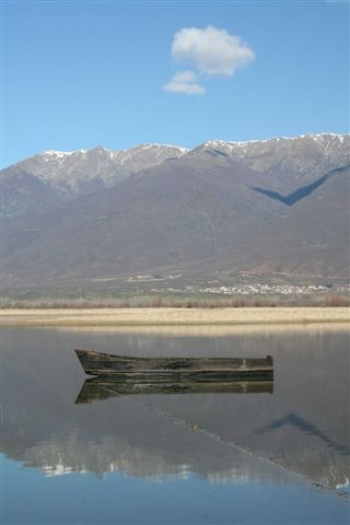

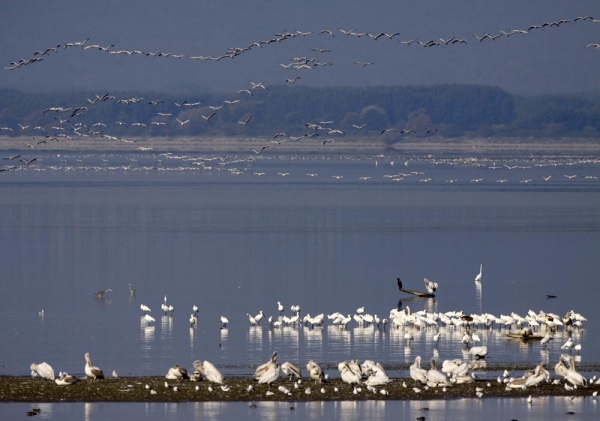

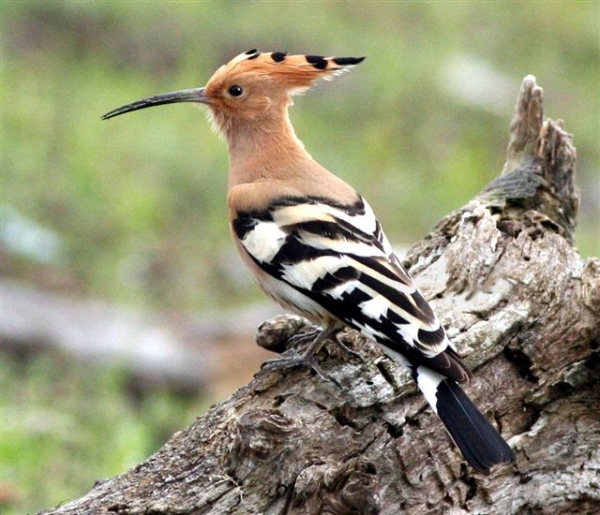
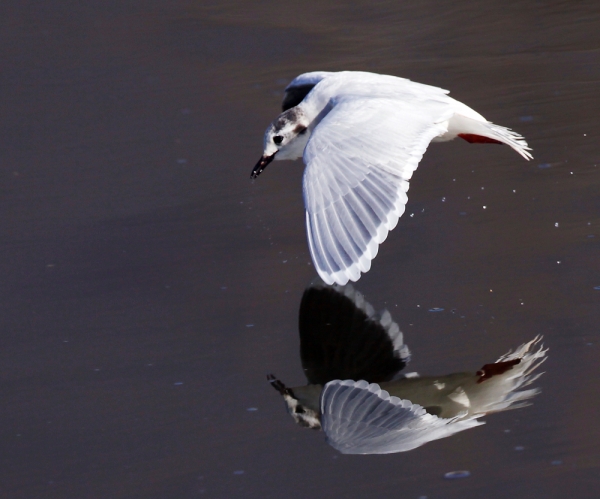
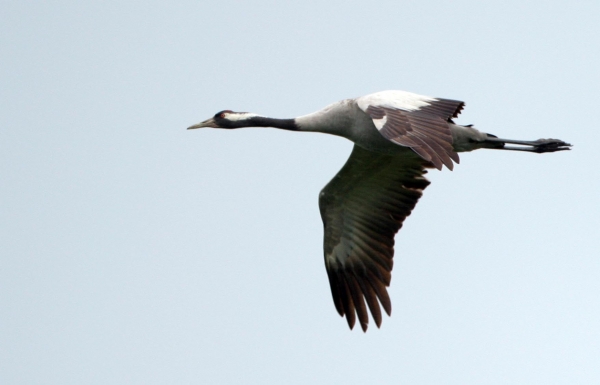

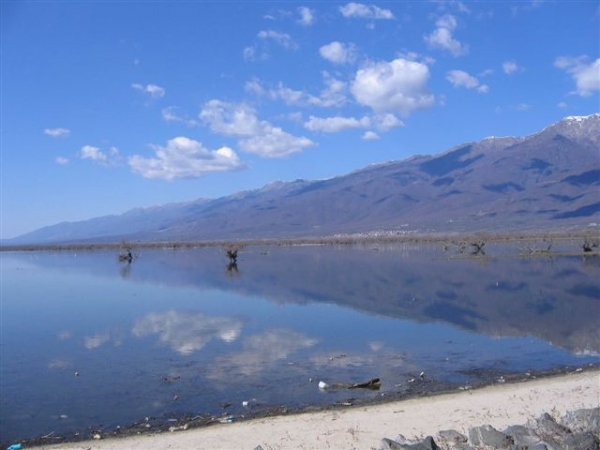

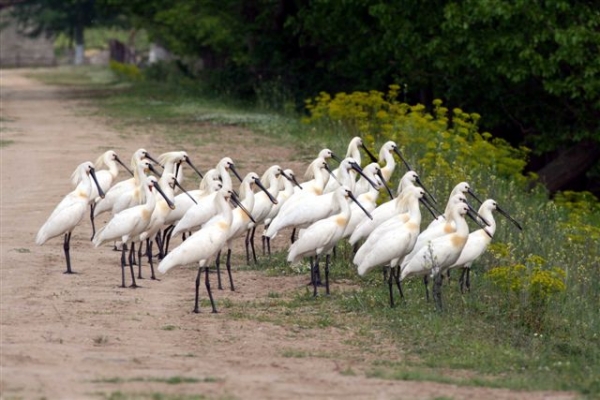
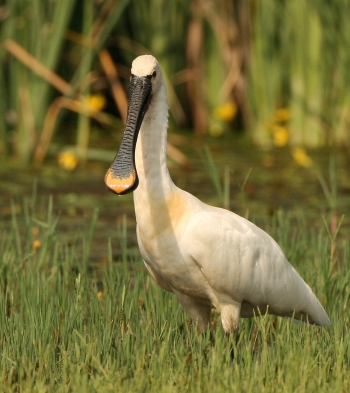

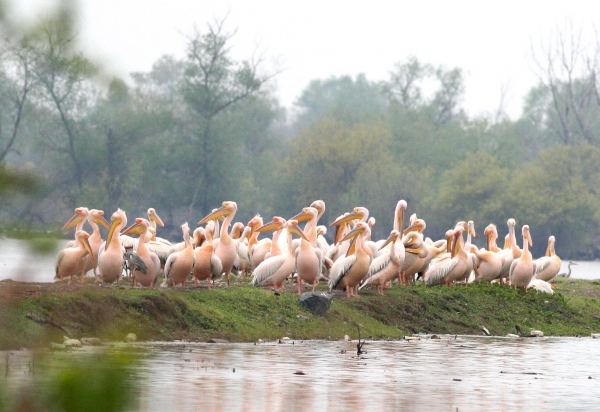

Answers to Birdfair Quiz!
- Honey Buzzard
- Black-headed Bunting
- Woodchat Shrike
- Hoopoe
- Long-legged Buzzard
- Collared Pratincole
- Tawny Pipit
- Golden Oriole
- Calandra Lark
- Spur-winged Plover
- Rock Thrush
- Broad-billed Sandpiper
- Shore Lark
- Booted Eagle
- Dalmatian Pelican
- Squacco Heron
- Cuckoo
- Lesser Kestrel
- Glossy Ibis
- Beeeater
- Blue Rock Thrush
- Ferruginous Duck
- Egyptian Vulture
- Grey-headed Woodpecker
- Black-necked Grebe
- Black Tern
- Montagu’s Harrier
- Levant Sparrowhawk
- Spanish Sparrow
- Black Woodpecker
- Black Vulture
- Little Bittern
- Red-footed Falcon
- White Stork
- White Pelican
- Black-eared Wheatear
How many did you get? Which did you find most difficult? Let us know your thoughts!
Email us at info@birdwing.eu or via our contact form.
Kerkini May 2013
A visit to Kerkini in May is always magical and our latest visit proved no different. With both breeding platforms full of Dalmatian Pelicans and plenty of Whites visiting from Prespa pelicans were much in evidence. Water levels are high so waders are thin on the ground but all the summer herons are in and a lingering immature Common Crane looks likely to summer here. Both light and dark phase Booted Eagles are in the Mavrovounas together with Black Kites and wonderfully displaying Honey Buzzards. Other raptors included Golden, White-tailed, Lesser Spotted and Short-toed Eagles, Levant Sparrowhawk, Peregrine and a single Eleonora's. Other birds of note were 6 Masked Shrikes, several singing Orphean and Olive-tree Warblers, Grey-headed and Lesser Spotted Woodpeckers, Rock Sparrow and Great Spotted Cuckoo.
Kerkini January - March 2013
Winter is gone, but it left important memories behind. Remarkable observations include various jackal groups in the perimeter of lake Kerkini and the frequent sighting of roe deer and boars on the low mountain ranges around the lake. A group of wolves was also spotted and observed (inasmuch as that is possible...) on the mountains of site 8 of Birdwatching in Northern Greece.
Also, otters have been making a strong showing thus far, in larger groups (up to 6 individuals together!) and more frequently than last year (mostly near site 4).
Another nice moment was the presence of 56 Lesser White-fronted Geese, who apparently finished the trip from Kerkini lake (last sighting 21/12/2012) to Evros river (arrival-first sighting 10/1/2013) safe and sound. The presence of at least 20 Spotted Eagles and some thousands of White-fronted Geese was also noted.
Among the more rare specimen that graced the biotope with their presence, at least 3 Golden Eagle, 2 White-tailed Eagle, 4-5 Peregrines and a youngling Imperial Eagle (not sighted very frequently) were observed in the general vicinity. We shouldn't however fail to mention the 2-3 Eagle Owls that reside in the forest and around the lake, as well as the 8-10 Marsh Harrier that made their presence clear on almost daily basis.
Hen Harrier, Comon Buzzards and smaller birds of prey complete the image of the predators of the lake, attracted and sustained by its abundant food sources.
A young Golden Eagle was also observed near site 7 (for the first time!) at 27/1, while two more younglings and an adult bird were simultaneously sighted in the Strimonas area near the border. This particular adult is the most recognizable by now, due to its characteristic markings.
In other news, Cranes started arriving around the 12/12, with a group of 4 (probably a family). By the 21/12 there were 10 of them, and by the 11/1 twelve. A month and a half later (28/2) there were a whole 28 of them!! All the while, a forgotten Hoopoe was observed (23/12), three White Pelicans give their unique color to the landscape and Great Grey Shrikes, just like every year, are sighted in their usual spots.
More than 10.000 Pochards offer amazing images with their massive maneuvers, and starting on the 20/12 a group of 21 Ferruginous Ducks rest for a few days near site 6.
Today... the (2) Egyptian Geese are still here, and don't look like they are leaving any time soon. With colleague (but mostly friend) Sotiris Mountzelos we observed three Imperial Eagle (adult, juvenile, subadult) above the northern part of the lake, and the last 2-3 Spotted Eagle. There are still enough Swans and some Flamingo. At the beginning of March another good friend, Giorgos Spyridakis, observed 48 Cranes gaining height (that means a longer travel) near site 7. About 220 Dalmatian Pelicans are occupying the artificial islands (of which almost 150 on the reproduction platforms), and many White Pelicans are moving to the shallower parts of the lake, in its northern part, adjacent to the forest. Near Limnochori village, in a poplar field, more than 70 Grey Herons nests have been counted, while, starting in mid-March, Pygmy Cormorants, Spoonbills and Grey Herons are establishing residency at the nests in the riparian forest. The Cormorans have started much sooner of course, so we are expecting the first young birds any time now.
More migratory species have started arriving - some to stay, some just to rest. With some luck and a lot of field hours, most of them can be spotted. I think that, especially during this period (mid-March tomid-April) one should be outside the whole day (and even the whole night- there's a lot going on during the night as well) in order to observe and admire the movements of our winged friends. Amongst others Pelicans have of course started arriving, and manning the first nests.
Spoonbills, various Waders, Imperial Eagle, Lesser-Spotted Eagle, Black Kites, Dalmatian Pelicans, White Pelicans, various Swallows and Martins, Osprey, Ruffs, Harriers, Short-toed Eagle, Herons, Penduline Tits, Gulls and lots of other birds are adorning the area with their presence. We expect a "rich" and thoroughly interesting period to follow.
Thanks are due to Kostas and the Management Authority for this report.
Kerkini November 2012
There are large flocks of duck, including Pochard, Mallard, Teal, Wigeon but also Shoveler that gradually increase their number ,as well as Pintails in various parts around the lake. There are also Ferruginous and Tufted Ducks in small numbers for the time being as well as Red-crested Pochard for the first time this year at the west embankment.
Theodoros Naziridis watched two Golden Eagles flying above the top of Belles mountain near Vironia (On the 11th of November we had noticed three of them, two adults and one young one). On 21st of November the first Crane was spotted for this year (unfortunately up till now there has been only one). An unusual visitor, a young Black-throated Loon appeared and has been currently present in the area of Limnohori. On 26th of November we ,my colleague Sotiris Mountzelos and I, had an unexpected and rare chance to watch and enjoy from a close distance a male Snow Bunting at the west part of the lake (this is the first time that we have spotted such a species in our area and the fifth time that such a bird is noticed in Greece).
As prey birds are concerned, we have noticed at least 5 or 6 Marsh Harrier flying above the river delta. It is relatively easy to watch male and female Hen Harrier, Sparrowhawk, Goshawk and Merlin flying in the perimeter of the lake as well as in the fields close by.
Everyday Peregrine Falcon (definitely 4-5 ) hunt either at the mouth of the river or at the delta or at the old river bed or at the area of Mandraki.
These days the Common Buzzards keep on appearing very often unexpectedly. The White-tailed Eagles are constant visitors to the inaccessible areas of the river mouth. At least 16 Spotted Eagles show up everyday at the riverside forest. On 11th November we counted 16 of them on the east side of the forest, the triangle ,delta up to the east embankment. We were lucky enough to witness stunning moments with 6 to 8 Spotted Eagles flying along side by side (20-30 meters) .We have also noticed at least one( I would say 2 ) Imperial Eagles usually up in a tree overseeing the area waiting for prey. Finally a Lesser Spotted Eagle that has been left behind and will probably spend the winter with us at the east embankment.
Lately the number of the geese has slightly increased (but there aren't many) according to our latest counting we have around 340 White-fronted Goose, 23 Greylag Goose, 2 Egyptian Goose and naturally the 56 Lesser White-fronted Goose that keep their population stable. Among them there are only 5 young ones. Along with them ,there are 4-5 Black storks and an equal number of white storks that daily feed mainly in the Strimona river as well as towards the riverside forest.
There are many Avocets and Lapwings that fly low in large groups. There are Swans that belong to the three species but not in large numbers .The sea gulls tend to form large flocks. There are White and Dalmatian Pelicans either together or separate ,either close or far away from each other. Among them we can spot two marked ones, Leyla and Odysseas that carry their radio transmitters on their backs with the valuable information.
Thanks to Kostas for the data.
Kerkini October 2012
On the 11th an adult Imperial Eagle that was above the eastern part of the drowned forest .
Around 7.000 Flamingos have been feeding across the whole northern part of the lake.
The first 12 Lesser White-Fronted Geese arrived at Kerkini on the 13th - numbers reached 23 on 20th - and joined 21 Greylags and 21 White-fronts.
5-6 Spotted Eagles are around, one with a metal ring on its left leg and a small flag among its feathers. It is hoped to find the country of origin by getting a better view of the flag.
There was one Short-eared Owl near the river forest, a Saker Falcon flying along Strymonas river and an Eagle Owl in the middle of the forest in a tall tree at midday.
At least 6 Marsh Harriers are in the area and one Peregrine Falcon uses the dry trunks that still remain standing in the water at the western part of the lake.
The Golden Eagles (sometimes the young bird along with the adults but other times separately) can be seen flying high on Belles mountain.
The White-tailed Eagles feed near the forest and at the mouth of the river. Lately they have been seen near the area of their nest early in the afternoon. On 15th three White – Tailed Eagles that were flying 200m above us attracted our attention. There were two adults and one young bird. The youngster and one of the adults were performing loops, tricks and fights. The sight was amazing. We have never witnessed such a happening before so close to us and so intense. The second adult bird was following keeping a safe distance.
The 16th had one Hobby, two Sparrowhawk and two Hen Harrier(one at the Koryfoudi and the other at Mandraki).
Some days ago we watched more than 100 Caspian Terns in the lake.
At least 5 Cattle Egret are in the area towards the Trigono and around 4.200 members of the Pochard flock are near Lithotopos village .
Kerkini August 2012
Sightings in August included Caspian Terns, 3 Golden Eagles - both adults and their yongster - Lesser Spotted Eagles with their young, Glossy Ibis and large numbers of Mallards and Teal. The monthly bird count found almost all the regular duck species present though in small numbers, more than 200 Flamingo, large numbers of Spoonbills, at least 20 Greylag Goose, more than 1000 White Pelicans, hundreds of Coots, Moorhens and smaller waders (mostly Tringa) along with some Night and Squacco Herons a few of which are lingering, and Short-toed Eagles, Lesser Spotted Eagles and Booted Eagles. A pleasant surprise was the presence of 15 Cattle Egrets (6 adults and 9 juveniles), the result of three pairs breeding for the first time.

